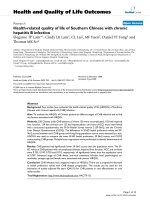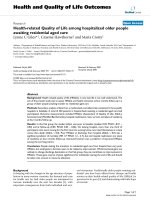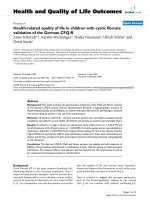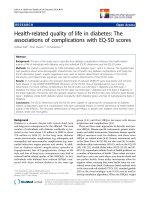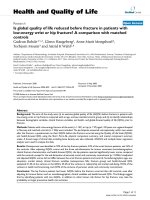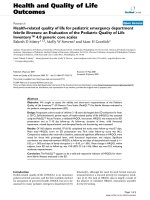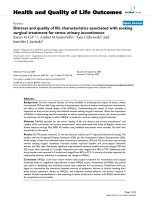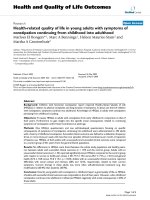báo cáo hóa học:"Decreased health-related quality of life in disease-free survivors of differentiated thyroid cancer in Korea" potx
Bạn đang xem bản rút gọn của tài liệu. Xem và tải ngay bản đầy đủ của tài liệu tại đây (356.04 KB, 10 trang )
RESEARC H Open Access
Decreased health-related quality of life in
disease-free survivors of differentiated thyroid
cancer in Korea
Ji In Lee
1
, Soo Hyun Kim
2
, Alice H Tan
1
, Hee Kyung Kim
1
, Hye Won Jang
1
, Kyu Yeon Hur
1
, Jae Hyeon Kim
1
,
Kwang-Won Kim
1
, Jae Hoon Chung
1
, Sun Wook Kim
1*
Abstract
Background: Concern regarding the health-related quality of life (HRQOL) of long-term survivors of thyroid cancer
has risen due to the rapid increase in the incidence of thyroid cancer, which generally has an excellent prognosis.
The aim of this study was to evaluate the status of HRQOL in disease-free survivors of differentiated thyroid
carcinoma (DTC) and to evaluate the important determinants of HRQOL.
Methods: This was a cross-sectional study in which we interviewed consecutive disease-free survivors of DTC.
Three different validated questionnaires ("EORTC QLQ-C30” for various functional domains, the “brief fatigue
inventory (BFI)” and the “hospital anxiety and depression scale” (HADS)) were used. Data from a large, population
based survey of 1,000 people were used as a control.
Results: The response rate for the questionnaires was 78.9% (316/401). Disease-free survivors of DTC showed a
decreased HRQOL in all five functional domains (physical, role, cognitive, emotional, and social) on the EORTC QLQ-
C30 compared with controls (P < 0.01). BFI and HADS-anxiety scores also showed greater distress in disease-free
survivors of DTC than in controls (P < 0.05). A multiple regression analysis for the determinants of HRQOL showed
that the HADS-anxiety, HADS-depression, and BFI scores were the most significant components of decreased
HRQOL.
Conclusions: Although disease-free survivors of DTC are expected to have disease-specific survival comparable to
the general population, they experience a significantly decreased HRQOL. Anxiety, depression, and fatigue were the
major determinants of the decreased HRQOL. Supportive psychological car e should be integrated into the
management of long-term survivors of DTC.
Background
The incidence of thyroid cancer is rapidly increasing in
Korea and in several parts of the world. Differentiated
thyroid carcinoma (DTC), mostly small papillary thyroid
carcinomas which show excellent prognosis [1-3],
account for the majority of the increased incidence.
Although there are some controversies in the manage-
ment of DTC (papillary and follicular thyroid carci-
noma), primary treatment typically consists of surgery,
radioactive iodine (RAI) ablation/treatment, and TSH
suppressive therapy with levo-th yroxine (T4). These
treatment options are accompanied by various kinds of
long-term complications such as voice change after thyr-
oid surgery and xe rostom ia after high cumulative dose
of RAI [4].
Since most patients with DTC become free of disease
after the initial treatment, the number of disease-free
survivors of thyroid cancer continues to grow. Health-
related quality of life (HRQOL) is an important factor in
caring for long-term survivors of various types of cancer,
and every cancer patient needs and deserves appropriate
help from health care providers in order to improve
their HRQOL [5].
* Correspondence:
1
Division of Endocrinology and Metabolism, Department of Medicine,
Samsung Medical Center, Sungkyunkwan University School of Medicine,
Seoul, Korea
Full list of author information is available at the end of the article
Lee et al. Health and Quality of Life Outcomes 2010, 8:101
/>© 2010 Lee et al; licensee BioMed Central Ltd. This is an Open Access article distributed under the terms of the Creative Commons
Attribution License (http://creativecom mons.org/licenses/by/2.0), which permits unrestricted use, distribution, and reproduction in
any medium , provided the original work is properly cited.
Despite the expectation of normal life expectancy for
most disease-free survivors of DTC, there are concerns
about their HRQOL. The results of many published
reports however, have been inconsistent. Some studies
that describe decreased HRQOL in patients with thyroid
cancer have been limited by small sample size [6-8], a
lack of comparison with healthy control group [6,7,9],
or lack of in formation regarding specific details about
thyroid cancer stage, type of thyroid surgery and radio-
iodine treatment [9]. Hoftijzer et al.reporteda
decreased HRQOL in 153 cured DTC patients com-
pared with the general population, and the most impor-
tant independent determinant for better HRQOL was
the duration of cure [10]. Contrarily, Peltrari et al.
found that the overall H RQOL of 341 patients with
DTC (stage I, II), whose initial treatment was performed
at least five years earlier, was comparable to that of the
general population [11]. These previous studies did not
address the application of a comprehensive panel of
quality of life and mental health instruments to a large
population of thyroid cancer survivors of diverse stages
by cancer-specific questionnaires.
The aim of this study was to compare the HRQOL for
disease-free survivors of DTC with that of the general
populat ion using validated questionnaires, and to evalu-
ate the important and manageable determinants, espe-
cially mental health instrument, of the HRQOL. We
also wanted to see whether the different treatment mod-
alities may affect HRQOL of disease-free survivors of
DTC.
Methods
Patients
The study involved consecutive disease-free patients
with DTC who visited the outpatient clinic of the Thyr-
oid Cancer Center, Samsung Medical Center between
July 2008 and October 2008. All patients older that 18
years of age were asked to participate and to complete
the written questionnaires by themselves at the outpati-
ent clinic. Inclusion criteria were having undergone
thyroid su rgery with or without radioiodine therapy, the
use of T4 replacement continuously for at least six
months, absence of clinical or laboratory evidence of
DTC at the time of the study, and no further planned
therapy for thyroid cancer except T4 replacement.
Exclusion criteria were any other acute or chronic co-
morbidity which required medical or surgical treatment
and could influence their HRQOL, and the administra-
tion of RAI within less than six months either for diag-
nostic or therape utic purposes since the recen t recovery
from hypothyroidism could affect the patient’sanswers.
The most commonly listed medical co-morbidities were:
diabetes mellitus, hypertension, coronary artery disease,
liver disease, kidney disease, lung disease and psychiatric
problem. Patients who had detectable thyroglobulin (Tg)
levels during TSH suppression or stimulation were also
excluded because these patients had a high likelihood
for requiring further treat ment, which could be a cause
of anxiety. Data on patient age and sex were derived
from the medical files: the patients were also asked
for additional data on marital status (married vs. not-
married), highest level of education achieved (graduated
from elementary school, middle school, high school,
college or university), employment status (employed vs.
not employed), religious status (reli gious vs. non-
religious) and subjectiv e financial status (low, middle, or
high economic class) using written questionnaire. Data
on disease severity parameters were derived from medi-
cal records as follows: histology, disease stage, type of
operation, number and cumulative dose of RAI, TSH
and free T3 level, and time since remission at the time
the questionnaire was administered. This study was
approv ed by the Inst itutional Review Board of Samsung
Medical Center. Written consent was obtained f rom all
participants.
Controls
Sex- and age- matched control group was adopted from
a previously published large-scale epidemiologic study to
provide reference data for HRQOL in the general Kor-
ean population [12,13]. In summary, 1000 members
(F:M = 1:1) of the general population from over 15 sites
in Korea were surveyed according to probability-propor-
tional-to-size technique. Eligibility criteria for control
included being physical ly and mentally well enough to
fill out a questionnaire of communicate with the
interviewer.
Instruments to Assess Health-related Quality of Life
1. European Organization for Research and Treatment
of Cancer Quality of Life Questionnaire Core 30 (EORTC
QLQ-C30)
The European Organization for Research and Treatment
of Cancer (EORTC) QLQ-C30 was developed in 1993
[14]. It is comprised of 30 cancer-spe cific questions
which are used to assess the HRQOL of cancer patients
who participate in clinical trials. It incorporates five
functional domains (physical, role, cognitive, emotional,
and social), three symptom scales (fatigue, pain, and
nausea-vomiting) a nd a global health/QOL scale. Each
of these multiple-item scales is scored from 0 to 100,
with a higher score representing better HRQOL. We
defined the patients group with a score of 33 or less in
the five functional domain and global health/QOL scale
as a problematic group according to previous literatures
[15,16]. Several single-item symptom measurements are
Lee et al. Health and Quality of Life Outcomes 2010, 8:101
/>Page 2 of 10
also included in EORTC QLQ-C30 and are used to
assess commonly reported problems in cancer patients
such as dyspnea, appetite loss, sleep distur bance, consti-
pation, diarrhea, and financial problems. However, only
thefivefunctionaldomainsandaglobalhealth/QOL
scales were used to assess the HRQOL in this study
because chemotherapy and conventional radiation ther-
apy are not used to treat patients with DTC as in other
cancers. The Korean version (Korean EORTC QLQ-
C30) was validated and w as demonstrated to have the
ability to distinguish the subgroups of patients with
different performance and HRQOL [17 ]. The use of this
questionnaire was permitted by the Quality of Life Unit
of the EORTC .
2. Brief Fatigue Inventory (BFI)
The BFI was developed for the rapid assessment of fati-
gue in cancer patients. The BFI consists of nine ques-
tions on a single page. Fatigue and its interference in
daily living are scored by patients on a numerical scale
from 0 to 10 [18]. The global score for the BFI is calcu-
lated as the mean value of these nine items. Fatigue
severity is then categorized into three groups: a global
score of 1-3 is considered mild; a score of 4-6 is moder-
ate; and a score of 7-10 is severe. The Korean version of
the BFI (BFI-K) has been validated and has demon-
strated reliability as a self-rating instrument used to
ass ess fatigue [19]. The BFI-K was provided by the Pain
Research Group of the MD Anderson Cancer Center
.
3. Hospital Anxiety and Depression (HADS)
The HADS was designed to assess depression and anxi-
ety in a medical or surgical outpatient setting that
includes cancer patients [20]. It consists of 14 questions
related to the two domains of depression and anxiety,
withsevenquestionsfocusondepression(HADS-D)
and the other seven focus on anxiety (HADS-A). Both
theHADS-AandHADS-Darescoredfrom0to21,
with higher scores indicating greater distress. A normal
value ranges from 0-7, a mild disorder ranges from 8-
10, a moderate disorder ranges from 11-14, and a severe
disorder ranges from 15-21. Th e Korean HADS has
been developed and validated [21]. A license for the
HADS-K was acquired from GL assessment htt p://www.
gl-assessment.co.uk.
Statistics
The EORTC QLQ-C30 was sc ored according to the
EORTC scoring manual. Incomplete questionnaires
were handled as per the developer’s recommendations.
BFI and HADS questionnaires with missing valu es were
not used. We used descriptive statistics for the socio-
demo graphic and clinico- pathologic features of t he sub-
jects. Differences in continuous variables between
participants and non-participants for the surve y were
tested by independent samples t-test. Differences
between groups in categorical variables were tested by
chi-square test and for small cell variables, Fisher`s
exact test. The one-sample t-test was used to compare
the means of each domain of questionnaires between
disease-free survivors of DTC and the ge neral popula-
tion controls. We used an analysis of covariance with a
gen eralized linear model to determine significant differ-
ences between the groups according to the mode of
treatment of thyroid cancer. Multiple regression analysis
was used to evaluate the predictors of HRQOL. The
independent variables used to predict each of the
EORTC QLQ-C30 domains included demographic fea-
tures (age at diagnosis, age at evaluation, gender, marital
status, level of education, employment, religion, and
financial status), clinical parameters (type of operation,
cancer stage, TSH level, cumulative RAI dose, and time
since remission), BFI scores, and the psychological status
of the patient (HADS-D and HADS-A scores). The vari-
ables that were P < 0.2 in univariate analysis of variance
tests or were known to be important determinants that
affect the HRQOL in oth er previously published studies
on this topic were included in these multiple regression
analysis [6-11,22-26]. P values of < 0.05 were considered
statistically significant.
Results
Recruitment results
We identified 681 consecutive patients at our outpatient
clinic who were potentially disease-free survivors of
DTC. Two hundred eighty (40.9%) of these patients were
excluded either because of a co-morbidity or because it
was less than six months after last the administration of
RAI. Eighty-five of the 401 (21.1% ) disease-free survivors
of DTC who were eligible declined participation, and
lack of time or inconvenience were the most commonly
stated reasons. There w ere no differences in the demo-
graphic and clinico-pathologic characteristics between
the participants and the non-participants (Table 1).
Three hundred sixteen (78.9%) disease-free survivors of
DTC ultimately participated in the study (Figure 1).
Patient Characteristics
The baseline clinical characteristics for the participants
are summarized in Table 2. Two hundred eighty-seven of
the 316 participants were female (90.8%). The mean age
(± SD) at the time of diagnosis was 41.2 years (± 9.8).
Most of the patients were married (91.9%, 274/298). Two
hundred fourteen of the 300 patients (71.3%) were reli-
gious, and 93.2% of the patients reported a subjective
financial status as middle class or higher. A majority of
the participants had papillary thyroid carci noma (97.5%,
Lee et al. Health and Quality of Life Outcomes 2010, 8:101
/>Page 3 of 10
308/316) and eight (2.5%) had follicular thyroid carci-
noma. A total thyroidectomy was performed in 89.9%
(284/316) of the patients, and 10.1% (32/316) had a sub-
total thyroidectomy or lobectomy. Based on TNM sta-
ging, 223 (70.6%) of the patients had stage I disease, five
(1.6%) had stage II disease, 82 (25.9%) had stage III dis-
ease, and six (1.9%) had an unknown stage. The mean
TSH level (± SD) at the time of the survey was 0.49
(±5.74) uIU/㎖, free T3 was 3.77 (± 0.93) pg/㎖.The
mean time since disease remission (± SD) was 37.3
months (28.8). RAI therapy was performed in 92.0%
(291/316) of the patients, with a mean cumulative RAI
dose (± SD) of 134.0 (± 101.0) mCi, and the mean num-
ber (± SD) of RAI therapy treatments was 2.6 (± 1.4).
Table 1 A comparison of demographic and clinicopathologic characteristics between participants and non-participants
Characteristics Participants (n = 316) Non-participants (n = 85) P value
Age at diagnosis (yr), mean (SD) 41.3 (9.8) 43.5 (10.2) 0.08
Gender
Female (%) 287 (90.8) 78 (91.5) 0.84
Marital status (%)
Married 274/298* (91.9) 55/63
§
(87.3) 0.23
Education (%)
>High school graduate 178/306* (58.2) 34/64
§
(53.1) 0.49
Employment status (%)
Employed 142/307* (46.3) 25/64
§
(39.1) 0.29
Religious (%)
Yes 214/300* (71.3) 42/61
§
(68.9) 0.67
Histology (%)
Papillary carcinoma 308 (97.5) 82 (97.2) 0.89
Follicular carcinoma 8 (2.5) 3 (2.8)
≥ Stage (AJCC6) III (%) 82 (26.5) 29 (33.8) 0.21
RAI, cumulative dose (mCi), mean (SD) 134.1 (101.1) 120.4 (83.3) 0.29
TSH (uIU/㎖), mean (SD) 0.5 (5.8) 0.2 (0.6) 0.70
Free T3 (pg/㎖), mean (SD) 3.8 (0.9) 3.7 (1.0) 0.36
Time since remission (months), mean (SD) 37.3 (28.8) 38.9 (27.7) 0.70
AJCC6, the American Joint Committee on Cancer 6; RAI, radioactive iodine therapy
* represents number of patients who replied to the specific question.
§
the timing of data collection for marital status, educational level, employment status and religion of non-participants was not at the time of study but at
admission for thyroid surgery or radioiodine treatment.
Figure 1 Recruitment responses to the survey questionnaire s. Four hundred one (59.1%) of 681 potentially disease-fre e survivors of DTC
from participating registries were eligible. Of the 401 disease-free DTC survivors, 316 (78.9%) answered the questionnaires.
Lee et al. Health and Quality of Life Outcomes 2010, 8:101
/>Page 4 of 10
Comparison of EORTC QLQ-C30, BFI, and HADS between
the Disease-Free Survivors of DTC and the General
Population
Results from the EORTC QLQ-C30 of the disease-free
survivors of DTC and the control group are compared
in Figure 2. The disease-free survivors of DTC showed
significantly lower scores in all of the functional
domains (physical, role, cognitive, emotional, and social),
as well as on the global health/QOL scale at the EORTC
QLQ-C30 survey (P < 0.05). Furthermore, the propor-
tion of problematic groups according to EORTC QLQ-
C30 was significantly higher in disease-free survivors of
DTC than controls for all functional domains and global
health/QOL scale except physical functioning domain
(Table 3). HADS-A, HADS-D, and BFI scores for the
disease-free survivors of DTC and the control group are
shown in Table 4. Dise ase-free survivors of DTC had
greater levels of distress according to the HADS-A and
BFI scores. Interestingly, the disease-free DTC patients
showed less distress in the HADS-D score compared
with the control group.
HRQOL according to the Mode of Treatment of Thyroid
Cancer
The functioning scales for the EORTC QLQ-C30,
HADS-A, HADS-D, and BFI did not show any differ-
ences between patients who underwent surgery alone
and patients who underwent surgery combined with
RAI therapy. T he cumulative dose of RAI also did not
affect the HRQOL in our study group (Table 5).
Determinants for HRQOL
Anxiety, depression and fatigue emerged as the stron-
gest determinants for most of the domains in the
EORTC QLQ-C30 in disease-free survivors of DTC
according to the multiple regression analysis. Fatigue
had negative influence on global health and QOL scale
(b = -0.50), physical functioning (b = -0.34), role func-
tioning (b = -0.57), emotional functioning (b = -0.25),
cognitiv e function ing (b = -0. 17), and social functioning
(b = -0.37). Anxiety had negative influence on physical
functioning (b = -1.02), emotional fu nctioning (b =
-3.45), cognitive functioni ng (b = -1.92) and social func-
tioning (b = -1.36). Depression had negative influ ence
on global health and QOL scale (b = -1.82), role func-
tioning (b = -1.41) and cognitive functioning (b= -1.52).
Increasing age at diagnosis (b = -0.27) and female gen-
der (b = -12.11) had a negative influence on the physical
functioning domain. Increasing age at evaluation had
negative infl uence on the physical functioni ng (b =
-0.37) and cognitive functioning (b = -0.23) and positive
influence on the emotional functioning (b = 0.20).
Patients who were employed at the time of evaluat ion
showed significantly b etter role functioning (b = 6.66)
and social functioning (b = 5.00). The frequenc y of RAI
therapy, cumulative dose of RAI, and level of TSH sup-
pression had no significant impact on the HRQOL of
the disease-free survivors of DTC. The regression coeffi-
cient of each variables, adjusted R
2
and significant
P values are described in Table 6.
Discussion
Our data supports the hypothesis that disease-free survi-
vors with DTC have decreased HRQOL, despite being
clinically-free of disease. Important determinants of
decreased HRQOL were the patients’ subjective fatigue,
Table 2 Clinical characteristics of disease-free survivors of
DTC
Characteristics Number of patients (n =
316)
%
Age at diagnosis (yr), mean (SD) 41.2 (9.8)
Age at evaluation (yr), mean (SD) 46.0 (9.2)
Gender
Female 287 90.8
Marital status (n = 298*)
Married 274 91.9
Education (n = 306*)
>High school graduate 178 58.2
Employment status (n = 307*)
Employed 142 46.3
Religious (n = 300*)
Yes 214 71.3
Subjective financial status (n = 294*)
≥Middle 274 93.2
Histology
Papillary carcinoma 308 97.5
Follicular carcinoma 8 2.5
Stage (AJCC6)
I 223 70.6
II 5 1.6
III 82 25.9
IV 0 0
Unknown 6 1.9
Operation
Total thyroidectomy 284 89.9
Subtotal/lobectomy 32 10.1
RAI therapy 291 92.0
RAI, cumulative dose (mCi), mean
(SD)
134.0 (101.0)
RAI, total frequency, mean (SD) 2.6 (1.4)
TSH (uIU/㎖), mean (SD) 0.49 (5.74)
Free T3 (pg/㎖), mean (SD) 3.77 (0.93)
Time since remission (months),
mean (SD)
37.3 (28.8)
AJCC6, American Joint Committee on Cancer, sixth edition, stage of disease;
RAI, radioactive iodine therapy
* represents number of patients who replied to the specific question.
Lee et al. Health and Quality of Life Outcomes 2010, 8:101
/>Page 5 of 10
anxiety, and depression. The modes of treatment
(including type of surgery, frequency and cumulative
dose of RAI, and level of TSH suppression) did not
affect HRQOL in this study population.
Our high response rate of 78.6% resulted in 316 parti-
cipants, making our study one of the largest to evaluate
HRQOL in thyroid cancer patients to date. Furthermore,
there were no differences in the demographic and clin-
ico-pathologic characteristics between the participants
and the non-participants. Data from a large, population-
based, cross-sectional survey of 1,000 Koreans was used
as a control in order to limit selection bias.
One limitation of our study was that even though the
size of the study population was not small, our study
subjects were homogenous in the method of treatment
they underwent (total thyroidectomy, 89.9%; at least one
dose of radioiodine administration, 92.1%; on T4 sup-
pressive therapy, 97.5%). Also, selection bias may have
Figure 2 Comparison of the health-related quality of life between disease-free survivors of differentiated thyroid carcinoma and age/
sex-matched controls. The disease-free survivors of DTC had a statistically significant decrease in all functional domains and global health/QOL
scale of EORTC QLQ-C30. *P < 0.05 from one-sample t-test
Table 3 Proportion of problematic groups (score≤33 on a
scale of 0 to 100) in functional domains and general
health/QOL scale of EORTC QLQ-C30
Disease-free survivors of
DTC
Controls P
value
Physical functioning 1.6% 1.9% 0.78
Role functioning 8.0% 2.5% <0.05
Emotional
functioning
9.3% 3.2% <0.05
Cognitive functioning 9.0% 2.0% <0.05
Social functioning 5.4% 1.9% <0.05
Global health/QOL
scale
17.3% 4.1% <0.05
Table 4 A comparison of the HADS and BFI scores
between the disease-free survivors of DTC and the
general population
Variable Disease-free survivors of DTC Controls
Mean Mean
HADS
Anxiety
†
6.2 5.3
Depression
†
5.7 6.6
BFI
†
4.4 3.4
HADS; Hospital Anxiety and Depressio n Scale. HADS-Anxiety and HADS-
Depression are scored from 0 to 21, w ith higher scores indicating greater
distress. Normal (0-7); mild disorder (8-10); moderate disorder (11-14); severe
disorder (15-21).
BFI; Brief Fatigue Inventory. global BFI score ranges from 0 to 10, with higher
scores indicating greater distress. Mild fatigue (1-3); moderate fatigue (4-6);
severe fatigue (7-10).
†
P < 0.05
Lee et al. Health and Quality of Life Outcomes 2010, 8:101
/>Page 6 of 10
been introduced due to the socioeconomic characteris-
tics of our institution’ s geographic location, and the
inherent limitation of a single-center study. More than
half of the patients (58.2%) had earned at least a college
degree, 93.2% of the patients classified themselves as
economically middle-class or above, and 90.8% of the
patients were women. Although we used general popula-
tion for controls in the comparisons, we should be cau-
tious in generalizing this study’ s results to all DTC
patients. Further investigation with a larger number of
Table 5 HRQOL according to the mode of treatment of thyroid cancer
Variables Surgery
alone
(n = 25)
Surgery and
RAI < 150 mCi
(n = 174)
Surgery and
RAI < 150 mCi
(n = 117)
mean (SD) mean (SD) mean (SD) P value
EORTC QLQ-C30
Global health status/QOL 57.99 (17.8) 57.90 (21.1) 57.97 (21.8) NS
Physical functioning 79.93 (13.5) 73.82 (17.1) 75.65 (14.1) NS
Role functioning 80.56 (20.6) 76.88 (22.41) 76.81 (23.7) NS
Emotional functioning 67.36 (24.8) 68.66 (23.20) 70.42 (19.6) NS
Cognitive functioning 76.39 (21.9) 69.85 (21.2) 74.64 (21.7) NS
Social functioning 82.64 (25.7) 81.50 (20.5) 81.01 (22.1) NS
HADS
Anxiety 6.63 (3.9) 6.28 (3.8) 6.15 (3.8) NS
Depression 6.21 (4.0) 5.80 (3.3) 6.15 (3.8) NS
BFI, mean score 4.13 (2.0) 4.36 (2.4) 4.53 (2.0) NS
HRQOL, Health-related quality of life; EORTC QLQ-C30, European Organization for Research and Treatment of Cancer Quality of Life Questionnaire Core 30; QOL,
quality of life; HADS, Hospital Anxiety and Depression Scale; BFI, Brief Fatigue Inventory; SD, standard deviation; RAI, radioactive iodine therapy; NS, not
significant
Each domain of EORTC QLQ-C30 are calculated and range s from 0 to 100 and the higher score represents a better level of HRQOL.
HADS; HADS-Anxiety and HADS-Depression are scored from 0 to 21, with higher scores indicating greater distress. Normal (0-7); mild disorder (8-10); moderate
disorder (11-14); severe disorder (15-21).
BFI; global BFI score ranges from 0 to 10, with higher scores indicating greater distress. Mild fatigue (1-3); moderate fatigue (4-6); severe fatigue (7-10).
Table 6 Determinants for HRQOL using multiple regression including demographic and clinical variables
Variables Global health
status/QOL
Physical
functioning
Role
functioning
Emotional
functioning
Cognitive
functioning
Social
functioning
Age at diagnosis, years - -0.27
a
- -0.21
b
Age at evaluation, years - -0.37
a
- 0.20
b
-0.23
b
Gender (male = 1,female = 2) - -12.11
a
- -7.47
b
Married (not married = 1, married = 2) - - - - - -
> High school graduate - - - - - -
(≤High school graduate = 1, > High school
graduate = 2)
Employed (not employed = 1, employed = 2) - - 6.66
a
- - 5.00
b
Religion (non-religious = 1, religious = 2) - - -6.07
b
- -5.97
b
-
≥ Middle class financial status - - - - - -
(<Middle class financial status = 1, ≥ Middle
class financial status = 2)
Operation (Total = 1,Subtotal/lobectomy = 2) -6.57
b
- - -
Disease stage (stage I,II = 1, stage III,IVa = 2) - - - - -4.92
b
-
TSH (uIU/㎖)
RAI, cumulative dose (mCi) - - - - - -
RAI, total frequency - - - - - -
Time since remission, months - - - - -0.11
a
-
BFI total score -0.50
a
-0.34
a
-0.57
a
-0.25
a
-0.17
b
-0.37
a
HADS, Anxiety - -1.02
a
- -3.45
a
-1.92
a
-1.36
a
HADS, Depression -1.82
a
- -1.41
a
- -1.52
a
-
Adjusted R
2
0.42 0.43 0.39 0.59 0.40 0.25
HRQOL, Health-related quality of life;
a
P < 0.01,
b
P < 0.05; P values are from a multiple regression analysis. The numbers in table are regression coefficient (the
average increment of HRQOL as the value of each variable one unit).
Lee et al. Health and Quality of Life Outcomes 2010, 8:101
/>Page 7 of 10
cured DTC patients with more diverse demographic and
clinico-pathologic profiles is needed. Furthermore, the
relatively short period of follow-up after the determina-
tion of cured status (median 2.7 year) precludes any
conclusions about the long-term outcomes in these
patients, thus follow-up studies should be performed.
The other limitation is that we used cancer specific
questionnaire “ EORTC QLQ-C30” in comparing the
general QOL between disease-free survivor and general
population. This might have caused some differences
from previous reports and future study using question-
naire assessing HRQOL in general population is needed.
Lastly, this study was cross-sectional design, which can
limit the generalizability of our findings to similar
groups of thyroid cancer survivors due to lack of validity
of the data collection, lack of initial HRQOL, anxiety,
depression and fatigue level and heterogeneous time
since the initial thyroid cancer treatment.
We included the EORTC QLQ-C30 in the set of ques-
tionnaires in this study. The EORTC QLQ-C30 is one of
the most commonly used questionnaires to evaluate
HRQOL in various types of cancer. However, to the
best of our knowledge, there has been only one report
regarding HRQOL using EORTC QLQ-C30 in patients
with DTC [27], in which the number of participants was
small (n = 62), and the disease status and treatment
modalities used for the patients were not specified. In
this study we used a group of patients who were all dis-
ease-free and included a much larger total number of
patients (n = 316).
Hoftijzer et al. reported that 153 patients who had
been cured of DTC had a decrease in QOL when com-
pared to their healthy controls (n = 113) using multiple
questionnaires (SF-36, MFI-20, HADS, SDQ). These
decreases were seen in 13 of 16 surveyed areas [10].
They reported that HRQOL may be restored to normal
after 12-20 years of follow-up. In our study, even though
the time elapsed since cure was relatively shorter (med-
ian 2.7 years; range 0.5-13.0) than that of Hoftijzer et
al’s study (median 6.3 years; range 0.3-41.8), the dura-
tion of cure when divided into two groups (<5 years and
≥5) did not influence any aspects of the HRQOL
domains of the EORTC QLQ-C30. On the other hand,
Pelttari et al. used a 15D questionnaire for their study
of 341 stage I or II DTC patients who were at least 5
years after cure [11]. They concluded that these cured
stage I or II DTC patients showed comparable HRQOL
to that of the general Finnish population. In our study,
we also incorporated patients with stage III DTC and
showed a decreased HRQOL across all stages. Thus, our
study corroborates the findings of Hoftijzer et al, [10] in
showing a decreased HRQOL for cured DTC patients
for at least 5-12 years during presumably one of the
most active stages of these patients’ lives, but deviates
from the research of Pelttari et al.
Tan et al. described that ethnicity may play a role in
HRQOL from a study conducted in 152 Singaporeans of
diverse ethnicity [22]. Tagay et al.alsoreportedthat
depression and anxiety in patients with D TC are highly
correlated with QOL. The most important determi nants
for depression and anxiety in their study were social
suppor t and a sence of coherence; whereas TSH did not
show a statistically significant association with depres-
sion or anxiety [23]. In addition, it has been reported
that patients with head and neck cancers who are more
optimistic have a higher HRQOL [28]. Hirsch et al.
reported that patients with thyroid cancer perceive their
illness on a subjective and emotional basis, not on the
objective severity of the DTC [29]. So, the influence of
different ethnic and cult ural background on the percep-
tion of illness may have impacted the HRQOL of the
cured DTC patients of our study and this may also
explain some of the conflicting results in previously
reported HRQOL studies. It is possible that in a predo-
minantly ethnically homogeneous country such as South
Korea, pervasive p erceptions regarding the diagnosis of
cancer may profoundly impact how an individual adjusts
to DTC. In this regards, the attitude and em otional sup-
port by healthcare-provider and family would be of
great importance on th e HRQOL of long-term survivors
of thyroid cancer.
In our study, as in previous studies, treatment modal-
ity did not affect HRQOL. The extent of surgery, as in
the report by Shah et al., did not impact HRQOL, there-
fore our findings support their stat ement that HRQOL
should not be a f actor in the decision of extent of sur-
gery in DTC patients [26] Likewise, we found no rela-
tionship between HRQOL and blood TSH level not only
as a continuous variable, but a lso when grouped into
suppressed (<0.5 uIU/㎖), normal (0.5-4.5 uIU/㎖)and
increased (>4.5 uIU/㎖) categories. A previous report by
Eustatia-Rutten et al. on a small number of patients
who were cured of DTC (n = 24) with > 10 years subcli-
nical hyperthyroidism also showed that HRQOL was
preserved except for only minor stable impairment on
somatic dysfunction. In their study, restoration of
euthyroidism after subclinical hyperthyroidism did not
result in consistent improvement of quality of life [25].
In a similar vein, Giusti et al.compared61DTC
patients with a control group consisting of patients on
T4 therapy for a non-toxic multi-nodular goiter and
found a decreased HRQOL in the DTC patients that
was not related to blood TSH levels [7].
In our stud y, 89.9% of the patients underwent total
thyroidectomy and 92% received RAI treatment at least
once. The revised American Thyroid Association (ATA)
Lee et al. Health and Quality of Life Outcomes 2010, 8:101
/>Page 8 of 10
guidelines in 2009 for management of DTC management
guidelines recommend near-total or total thyroidectomy
without prophylactic central neck dissection, RAI abla-
tion in selected patients, and maintenance of the TSH at
or slightly below the lower limit of normal (0.1-0.5 uIU/
㎖) for P TC patients at low risk for r ecurrence [4]. Con-
sidering that 93 DTC patients were stratified into the low
risk for recurrence category in our study according to the
revised ATA guideline, the issue of over-treatment
according to older guidelines could be suggested. How-
ever, we found no significant differences in HRQOL
according to treatment modalities even though the statis-
tical power was weak because most of the patients under-
went total thyroidectomy and RAI treatment. The impact
of treat ment modality needs further assessment with lar-
ger number of patients in the future.
We observed that the marital status, edu cati on, finan-
cial status had little impact on HRQOL. Multivariate
analysis revealed that being employed status had a posi-
tive influence on role functioning. This reinforces the
beneficial effects of the work on their lives or shows
that these patient s were less affected by the disease and
thus still able to continue working.
Lastly, in a study from Germany, Tagay et al.showed
a decreased HRQOL and a high prevalence of anxiety in
DTC patients on T4 suppression therapy, but the preva-
lence of depression was not increased [23]. Similarly, we
found significantly increased HADS-A scores in our
subjects compared to that of the general population
control. However, the HADS-D scores were significantly
lower in the disease-free DTC patients than in the con-
trols. One possible explanation is that TSH suppression
in the patient group might be related to t he lower
HADS-D scores. Further study is required to investigate
the relationship between TSH suppression, depression,
and anxiety.
Conclusion
Our study shows that disease-free survivors of DTC
patients experience significantly decreased HRQOL in
all functional domains of the EORTC QLQ-C30. Anxi-
ety, depression, and fatigue were the major determinants
of decreased HRQOL, and further studies are needed to
identify their root causes. Anticipatory guidance, psy-
chological supportive care, and improved counseling by
physicians and other health care providers who treat
disease-free survivors of DTC may lead to improved
HRQOL. Studies looking at effective mana gement stra-
tegies to ameliorate psychologic disturbances in these
patients are also warranted.
Acknowledgements
This research project was funded by the IN-SUNG Foundation for Medical
Research, Korea (grant number CA88221).
Author details
1
Division of Endocrinology and Metabolism, Department of Medicine,
Samsung Medical Center, Sungkyunkwan University School of Medicine,
Seoul, Korea.
2
Department of Nursing, Inha University, Incheon, Korea.
Authors’ contributions
JIL contributed the study design, data collection, statistical analysis,
interpretation of data and draft of the paper and revision of the manuscript.
SWK contributed to the study design, interpretation of data, draft of the
paper and revision of the manuscript. SHK contributed to data analysis and
interpretation of data. AHT contributed to the draft and revision of the
manuscript. HKK, HWJ, KYH, JHK contributed to data collection and
interpretation of data. KWK and JHC supervised execution of the study. All
authors read and approved the final manuscript.
Competing interests
The authors declare that they have no competing interests.
Received: 4 December 2009 Accepted: 15 September 2010
Published: 15 September 2010
References
1. NationalCancer Center of Korea: Cancer Registry and Statistics between
2003-2005. National Cancer Centre 2008 [].
2. Leenhardt L, Grosclaude P, Cherie-Challine L: Increased incidence of
thyroid carcinoma in france: a true epidemic or thyroid nodule
management effects? Report from the French Thyroid Cancer
Committee. Thyroid 2004, 14(12):1056-1060.
3. Davies L, Welch HG: Increasing incidence of thyroid cancer in the United
States, 1973-2002. Jama 2006, 295(18):2164-2167.
4. Cooper DS, Doherty GM, Haugen BR, Kloos RT, Lee SL, Mandel SJ,
Mazzaferri EL, McIver B, Pacini F, Schlumberger M, Sherman SI, Steward DL,
Tuttle RM: Revised American Thyroid Association management
guidelines for patients with thyroid nodules and differentiated thyroid
cancer. Thyroid 2009, 19(11):1167-1214.
5. Bottomley A, Aaronson NK: International perspective on health-related
quality-of-life research in cancer clinical trials: the European
Organisation for Research and Treatment of Cancer experience. J Clin
Oncol 2007, 25(32):5082-5086.
6. Botella-Carretero JI, Galan JM, Caballero C, Sancho J, Escobar-Morreale HF:
Quality of life and psychometric functionality in patients with
differentiated thyroid carcinoma. Endocr Relat Cancer 2003, 10(4):601-610.
7. Giusti M, Sibilla F, Cappi C, Dellepiane M, Tombesi F, Ceresola E, Augeri C,
Rasore E, Minuto F: A case-controlled study on the quality of life in a
cohort of patients with history of differentiated thyroid carcinoma. J
Endocrinol Invest 2005, 28(7):599-608.
8. Tagay S, Herpertz S, Langkafel M, Erim Y, Bockisch A, Senf W, Gorges R:
Health-related Quality of Life, depression and anxiety in thyroid cancer
patients. Qual Life Res 2006, 15(4):695-703.
9. Schultz PN, Stava C, Vassilopoulou-Sellin R: Health profiles and quality of
life of 518 survivors of thyroid cancer. Head Neck 2003, 25(5):349-356.
10. Hoftijzer HC, Heemstra KA, Corssmit EP, van der Klaauw AA, Romijn JA,
Smit JW: Quality of life in cured patients with differentiated thyroid
carcinoma. J Clin Endocrinol Metab 2008, 93(1):200-203.
11. Pelttari H, Sintonen H, Schalin-Jantti C, Valimaki MJ: Health-related quality
of life in long-term follow-up of patients with cured TNM Stage I or II
differentiated thyroid carcinoma. Clin Endocrinol (Oxf) 2009, 70(3):493-497.
12. Yun YH, Kim SH, Lee KM, Park SM, Kim YM: Age, sex, and comorbidities
were considered in comparing reference data for health-related quality
of life in the general and cancer populations. J Clin Epidemiol 2007,
60(11):1164-1175.
13. Yun YH, Lee MK, Chun HN, Lee YM, Park SM, Mendoza TR, Wang XS,
Cleeland CS: Fatigue in the general Korean population: application and
normative data of the Brief Fatigue Inventory. J Pain Symptom Manage
2008, 36(3):259-267.
14. Aaronson NK, Ahmedzai S, Bergman B, Bullinger M, Cull A, Duez NJ,
Filiberti A, Flechtner H, Fleishman SB, de Haes JC, Kaasa S, Klee M, Osoba D,
Razavi D, Rofe PB, Schraub S, Sneeuw K, Sullivan M, Takeda F: The
European Organization for Research and Treatment of Cancer QLQ-C30:
a quality-of-life instrument for use in international clinical trials in
oncology. J Natl Cancer Inst 1993,
85(5):365-376.
Lee et al. Health and Quality of Life Outcomes 2010, 8:101
/>Page 9 of 10
15. Hjermstad MJ, Fayers PM, Bjordal K, Kaasa S: Health-related quality of life
in the general Norwegian population assessed by the European
Organization for Research and Treatment of Cancer Core Quality-of-Life
Questionnaire: the QLQ = C30 (+ 3). J Clin Oncol 1998, 16(3):1188-1196.
16. Fayers PM: Interpreting quality of life data: population-based reference
data for the EORTC QLQ-C30. Eur J Cancer 2001, 37(11):1331-1334.
17. Yun YH, Park YS, Lee ES, Bang SM, Heo DS, Park SY, You CH, West K:
Validation of the Korean version of the EORTC QLQ-C30. Qual Life Res
2004, 13(4):863-868.
18. Mendoza TR, Wang XS, Cleeland CS, Morrissey M, Johnson BA, Wendt JK,
Huber SL: The rapid assessment of fatigue severity in cancer patients:
use of the Brief Fatigue Inventory. Cancer 1999, 85(5):1186-1196.
19. Yun YH, Wang XS, Lee JS, Roh JW, Lee CG, Lee WS, Lee KS, Bang SM,
Mendoza TR, Cleeland CS: Validation study of the korean version of the
brief fatigue inventory. J Pain Symptom Manage 2005, 29(2):165-172.
20. Zigmond AS, Snaith RP: The hospital anxiety and depression scale. Acta
Psychiatr Scand 1983, 67(6):361-370.
21. Oh SMMK, Park D: A study on the standardization of the hospital anxiety
and depression scale for Koreans - A comparison of normal, depressed
and anxious groups J Korean Neuropsychiatr Assoc 1999, 38(2):289-296.
22. Tan LG, Nan L, Thumboo J, Sundram F, Tan LK: Health-related quality of
life in thyroid cancer survivors. Laryngoscope 2007, 117(3):507-510.
23. Tagay S, Herpertz S, Langkafel M, Erim Y, Freudenberg L, Schopper N,
Bockisch A, Senf W, Gorges R: Health-related quality of life, anxiety and
depression in thyroid cancer patients under short-term hypothyroidism
and TSH-suppressive levothyroxine treatment. Eur J Endocrinol 2005,
153(6):755-763.
24. Tagay S, Senf W, Schopper N, Mewes R, Bockisch A, Gorges R: [Protective
factors for anxiety and depression in thyroid cancer patients]. Z
Psychosom Med Psychother 2007, 53(1):62-74.
25. Eustatia-Rutten CF, Corssmit EP, Pereira AM, Frolich M, Bax JJ, Romijn JA,
Smit JW: Quality of life in longterm exogenous subclinical
hyperthyroidism and the effects of restoration of euthyroidism, a
randomized controlled trial. Clin Endocrinol (Oxf) 2006, 64(3):284-291.
26. Shah MD, Witterick IJ, Eski SJ, Pinto R, Freeman JL: Quality of life in
patients undergoing thyroid surgery. J Otolaryngol 2006, 35(4):209-215.
27. Roberts KJ, Lepore SJ, Urken ML: Quality of life after thyroid cancer: an
assessment of patient needs and preferences for information and
support. J Cancer Educ 2008, 23(3):186-191.
28. Kung S, Rummans TA, Colligan RC, Clark MM, Sloan JA, Novotny PJ,
Huntington JL: Association of optimism-pessimism with quality of life in
patients with head and neck and thyroid cancers.
Mayo Clin Proc 2006,
81(12):1545-1552.
29. Hirsch D, Ginat M, Levy S, Benbassat C, Weinstein R, Tsvetov G, Singer J,
Shraga-Slutzky I, Grozinski-Glasberg S, Mansiterski Y, Shimon I, Reicher-Atir R:
Illness perception in patients with differentiated epithelial cell thyroid
cancer. Thyroid 2009, 19(5):459-465.
doi:10.1186/1477-7525-8-101
Cite this article as: Lee et al.: Decreased health-related quality of life in
disease-free survivors of differentiated thyroid cancer in Korea. Health
and Quality of Life Outcomes 2010 8:101.
Submit your next manuscript to BioMed Central
and take full advantage of:
• Convenient online submission
• Thorough peer review
• No space constraints or color figure charges
• Immediate publication on acceptance
• Inclusion in PubMed, CAS, Scopus and Google Scholar
• Research which is freely available for redistribution
Submit your manuscript at
www.biomedcentral.com/submit
Lee et al. Health and Quality of Life Outcomes 2010, 8:101
/>Page 10 of 10
